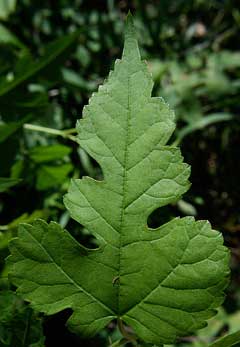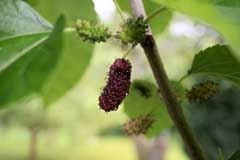 |
|
http://en.wikipedia.org/wiki/User:IvanTortuga |
 |
|
Translate this page:
Summary
Form: Rounded, Spreading or horizontal.
Physical Characteristics

 Morus rubra is a deciduous Tree growing to 15 m (49ft 3in) at a medium rate.
Morus rubra is a deciduous Tree growing to 15 m (49ft 3in) at a medium rate.
See above for USDA hardiness. It is hardy to UK zone 5. It is in flower in May, and the seeds ripen from July to August. The species is dioecious (individual flowers are either male or female, but only one sex is to be found on any one plant so both male and female plants must be grown if seed is required). . The plant is not self-fertile.
It is noted for attracting wildlife.
Suitable for: light (sandy), medium (loamy) and heavy (clay) soils and prefers well-drained soil. Suitable pH: mildly acid, neutral and basic (mildly alkaline) soils. It can grow in semi-shade (light woodland) or no shade. It prefers moist soil.
UK Hardiness Map
US Hardiness Map
Synonyms
Plant Habitats
Woodland Garden Secondary; Sunny Edge;
Edible Uses
Edible Parts: Fruit Leaves Shoots
Edible Uses:
Fruit - raw, cooked or made into preserves[2, 3, 21, 62, 149, 183]. Large and sweet with a good flavour, the fruit can be up to 3cm long[200]. The fruit can also be dried and ground into a powder[183]. This is used to make a delicious confection with almonds and other nuts[183]. The fruit is soft and juicy, when fully ripe it falls from the tree and is easily squashed[227]. Unripe fruits can cause stomach disorders[226]. Young shoots and unfolding leaves - raw or cooked. The related White Mulberry (Morus alba) has edible young leaves and shoots eaten cooked[105, 183] but we have found no information for this plant.
References More on Edible Uses
Medicinal Uses
Plants For A Future can not take any responsibility for any adverse effects from the use of plants. Always seek advice from a professional before using a plant medicinally.
Anthelmintic Cathartic Dysentery Febrifuge
The root bark is anthelmintic and cathartic[21]. A tea made from the roots has been used in the treatment of weakness, difficult urination, dysentery, tapeworms and as a panacea[222, 257]. The sap is used in the treatment of ringworm[222, 257]. Another report says that the milky juice obtained from the axis of the leaf is used[21]. The fruits are used to reduce fevers[222].
References More on Medicinal Uses
The Bookshop: Edible Plant Books
Our Latest books on Perennial Plants For Food Forests and Permaculture Gardens in paperback or digital formats.

Edible Tropical Plants
Food Forest Plants for Hotter Conditions: 250+ Plants For Tropical Food Forests & Permaculture Gardens.
More

Edible Temperate Plants
Plants for Your Food Forest: 500 Plants for Temperate Food Forests & Permaculture Gardens.
More

More Books
PFAF have eight books available in paperback and digital formats. Browse the shop for more information.
Shop Now
Other Uses
Fibre Wood
Agroforestry uses: Mulberry trees can be used for shade, erosion control, and as a forage source for livestock. The leaves are particularly valuable as food for silkworms. Additionally, they can improve soil structure and health. A cloth can be made from the fibrous bark[149]. Wood - coarse-grained, light, very durable, not strong, soft, rather tough. It weighs about 45lb per cubic foot and is used for boats, fencing and cooperage[46, 61, 82, 227, 229]. 1. Nectary - Flowers rich in nectar and pollen:
No – Mulberry flowers are wind-pollinated and not particularly rich in nectar or pollen for attracting pollinators.
2. Wildlife - Food (Fruit, Seeds, Leaf litter, Shelter, Nesting, Roosting):
Yes – Mulberries produce abundant fruit that provides food for birds, mammals, and insects. The dense foliage can serve as shelter, and the tree’s structure supports nesting and roosting for birds.
3. Invertebrate Shelter (Overwintering sites, Leaf litter, Groundcover):
Yes – Mulberry trees have rough bark that can shelter invertebrates. Leaf litter and groundcover from fallen leaves provide overwintering sites for beneficial insects.
4. Pest Confuser (Smell):
No – Mulberry trees do not have a strong aroma that would confuse or deter pests.
Special Uses
Food Forest
References More on Other Uses
Cultivation details
Landscape Uses:Pest tolerant, Aggressive surface roots possible, Pollard. Prefers a warm well-drained loamy soil in a sunny position[1, 11]. The red mulberry is sometimes cultivated for its edible fruit, there are some named varieties[183]. It is said to be of no value as a fruiting tree in Britain[1, 11]. Trees come into bearing when about 10 years old, fruiting best between the ages of 30 - 85 years and declining from the age of 125 years[227]. A good plant to grow grapes into. The grapes are difficult to pick but they always seem to be healthier and free from fungal diseases[201]. Mulberries have brittle roots and so need to be handled with care when planting them out[238]. Any pruning should only be carried out in the winter when the plant is fully dormant because mulberries bleed badly when cut[238]. Ideally prune only badly placed branches and dead wood[238]. Plants in this genus are notably resistant to honey fungus[200]. Dioecious[229] Male and female plants must be grown if fruit is required. Special Features:
Not North American native, Naturalizing, There are no flowers or blooms. The plant is heat tolerant in zones 9 through 5. (Plant Hardiness Zones show how well plants withstand cold winter temperatures.
Plant Heat Zones show when plants would start suffering from the heat.
The Plant Heat Zone map is based on the number of "heat days" experienced in a given area where the temperature climbs to over 86 degrees F (30°C).
At this temperature, many plants begin to suffer physiological damage. Heat Zones range from 1 (no heat days) to 12 (210 or more heat days).
For example Heat Zone. 11-1 indicates that the plant is heat tolerant in zones 11 through 1.) For polyculture design as well as the above-ground architecture (form - tree, shrub etc. and size shown above) information on the habit and root pattern is also useful and given here if available. The plant growth habit is a standard with a non-suckering single trunk [1-2]. The root pattern is a heart root, dividing from the crown into several primary roots going down and out [1-2]. The root pattern is a tap root similar to a carrot going directly down [1-2]. Mulberries are typically harvested in late Spring to early Summer, depending on the specific variety and local climate conditions.
Mulberry trees flower in Spring. Mulberry trees are considered fast-growing, often reaching heights of 6-12 meters (20-40 feet) within a few years under optimal conditions.
References Carbon Farming Information and Carbon Sequestration Information
Temperature Converter
Type a value in the Celsius field to convert the value to Fahrenheit:
Fahrenheit:
The PFAF Bookshop
Plants For A Future have a number of books available in paperback and digital form. Book titles include Edible Plants, Edible Perennials, Edible Trees,Edible Shrubs, Woodland Gardening, and Temperate Food Forest Plants. Our new book is Food Forest Plants For Hotter Conditions (Tropical and Sub-Tropical).
Shop Now
Plant Propagation
The seed germinates best if given 2 - 3 months cold stratification[80, 98]. Sow the seed as soon as it is ripe if possible, otherwise in February in a cold frame. The seed usually germinates in the first spring, though it sometimes takes another 12 months. Prick out the seedlings into individual pots when they are large enough to handle and grow them on in the cold frame for their first winter. Plant them out in late spring or early summer after the last expected frosts. Cuttings of half-ripe wood, 7 - 10cm with a heel, July/August in a frame. Plant out in spring. A good percentage take, though they sometimes fail to thrive[78, 113]. Cuttings of mature wood of the current season's growth, 25 - 30cm with a heel of 2 year old wood, autumn or early spring in a cold frame or a shady bed outside[78, 113,200]. Bury the cuttings to threequarters of their depth. Layering in autumn[200].
Other Names
If available other names are mentioned here
Native Range
NORTHERN AMERICA: Canada, Ontario (southeast), United States, Connecticut, Indiana, Massachusetts (west), Michigan (south), New Jersey, New York, Ohio, Pennsylvania (east & south), Rhode Island (north), Vermont (south), West Virginia, Illinois, Iowa, Kansas (east & central), Minnesota (southeast), Missouri, Nebraska (east & central), Oklahoma, Wisconsin, Alabama, Arkansas, Florida, Georgia, Kentucky, Louisiana, Maryland, Mississippi, North Carolina, South Carolina, Tennessee, Virginia, District of Columbia, Texas,
Weed Potential
Right plant wrong place. We are currently updating this section.
Please note that a plant may be invasive in one area but may not in your area so it's worth checking.
Conservation Status
IUCN Red List of Threatened Plants Status :

Growth: S = slow M = medium F = fast. Soil: L = light (sandy) M = medium H = heavy (clay). pH: A = acid N = neutral B = basic (alkaline). Shade: F = full shade S = semi-shade N = no shade. Moisture: D = dry M = Moist We = wet Wa = water.
Now available:
Food Forest Plants for Mediterranean Conditions
350+ Perennial Plants For Mediterranean and Drier Food Forests and Permaculture Gardens.
[Paperback and eBook]
This is the third in Plants For A Future's series of plant guides for food forests tailored to
specific climate zones. Following volumes on temperate and tropical ecosystems, this book focuses
on species suited to Mediterranean conditions—regions with hot, dry summers and cool, wet winters,
often facing the added challenge of climate change.
Read More
Expert comment
Author
L.
Botanical References
1143200
Links / References
For a list of references used on this page please go here
Readers comment
| Add a comment |
|
If you have important information about this plant that may help other users please add a comment or link below. Only comments or links that are felt to be directly relevant to a plant will be included. If you think a comment/link or information contained on this page is inaccurate or misleading we would welcome your feedback at [email protected]. If you have questions about a plant please use the Forum on this website as we do not have the resources to answer questions ourselves.
* Please note: the comments by website users are not necessarily those held by PFAF and may give misleading or inaccurate information.
To leave a comment please Register or login here All comments need to be approved so will not appear immediately.
|
|